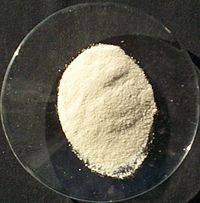Cerium(IV) oxide
 |
|
 |
|
| Names | |
|---|---|
|
IUPAC name
Cerium(IV) oxide
|
|
| Other names
Ceric oxide,
Ceria, Cerium dioxide |
|
| Identifiers | |
|
1306-38-3 12014-56-1 (monohydrate) |
|
| 3D model (Jmol) | Interactive image |
| ChEBI |
CHEBI:79089 |
| ChemSpider |
8395107 |
| ECHA InfoCard | 100.013.774 |
| PubChem | 73963 |
| UNII |
619G5K328Y |
|
|
|
|
| Properties | |
| CeO2 | |
| Molar mass | 172.115 g/mol |
| Appearance | white or pale yellow solid, slightly hygroscopic |
| Density | 7.215 g/cm3 |
| Melting point | 2,400 °C (4,350 °F; 2,670 K) |
| Boiling point | 3,500 °C (6,330 °F; 3,770 K) |
| insoluble | |
| +26.0·10−6 cm3/mol | |
| Structure | |
| cubic (fluorite) | |
| Hazards | |
| NFPA 704 | |
| Related compounds | |
|
Related compounds
|
Cerium(III) oxide |
|
Except where otherwise noted, data are given for materials in their standard state (at 25 °C [77 °F], 100 kPa).
|
|
|
|
|
| Infobox references | |
Cerium(IV) oxide, also known as ceric oxide, ceric dioxide, ceria, cerium oxide or cerium dioxide, is an oxide of the rare earth metal cerium. It is a pale yellow-white powder with the chemical formula CeO2. It is an important commercial product and an intermediate in the purification of the element from the ores. The distinctive property of this material is its reversible conversion to a nonstoichiometric oxide.
Cerium occurs naturally as a mixture with other rare earth elements in its principal ores bastnaesite and monazite. After extraction of the metal ions into aqueous base, Ce is separated from that mixture by addition of an oxidant followed by adjustment of the pH. This step exploits the low solubility of CeO2 and the fact that other rare earth elements resist oxidation.
Cerium(IV) oxide is formed by the calcination of cerium oxalate or cerium hydroxide.
Cerium also forms cerium(III) oxide, Ce
2O
3, which is an unstable that will oxidize to cerium(IV) oxide.
Cerium oxide adopts the fluorite structure, space group Fm3m, #225 containing 8-coordinate Ce4+ and 4 coordinate O2−. At high temperatures it releases oxygen to give a non-stoichiometric, anion deficient form that retains the fluorite lattice. This material has the formula CeO(2-x) where 0 < < 0.28. The value of depends on both the temperature and the oxygen partial pressure. The equation
...
Wikipedia


